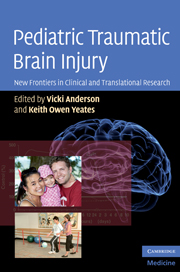Book contents
- Frontmatter
- Contents
- List of contributors
- Acknowledgments
- Introduction: Pediatric traumatic brain injury: New frontiers in clinical and translational research
- 1 Biomechanics of pediatric TBI
- 2 Neurobiology of TBI sustained during development
- 3 Using serum biomarkers to diagnose, assess, treat, and predict outcome after pediatric TBI
- 4 Clinical trials for pediatric TBI
- 5 Advanced neuroimaging techniques in children with traumatic brain injury
- 6 Neurobehavioral outcomes of pediatric mild traumatic brain injury
- 7 Very long-term neuropsychological and behavioral consequences of mild and complicated mild TBI: increased impact of pediatric versus adult TBI
- 8 Neurobehavioral outcomes of pediatric traumatic brain injury
- 9 Neuropsychological rehabilitation in children with traumatic brain injuries
- 10 Psychosocial interventions
- 11 Pediatric TBI: challenges for treatment and rehabilitation
- 12 Integrating multidisciplinary research for translation from the laboratory to the clinic
- Index
- Plate section
- References
11 - Pediatric TBI: challenges for treatment and rehabilitation
Published online by Cambridge University Press: 14 May 2010
- Frontmatter
- Contents
- List of contributors
- Acknowledgments
- Introduction: Pediatric traumatic brain injury: New frontiers in clinical and translational research
- 1 Biomechanics of pediatric TBI
- 2 Neurobiology of TBI sustained during development
- 3 Using serum biomarkers to diagnose, assess, treat, and predict outcome after pediatric TBI
- 4 Clinical trials for pediatric TBI
- 5 Advanced neuroimaging techniques in children with traumatic brain injury
- 6 Neurobehavioral outcomes of pediatric mild traumatic brain injury
- 7 Very long-term neuropsychological and behavioral consequences of mild and complicated mild TBI: increased impact of pediatric versus adult TBI
- 8 Neurobehavioral outcomes of pediatric traumatic brain injury
- 9 Neuropsychological rehabilitation in children with traumatic brain injuries
- 10 Psychosocial interventions
- 11 Pediatric TBI: challenges for treatment and rehabilitation
- 12 Integrating multidisciplinary research for translation from the laboratory to the clinic
- Index
- Plate section
- References
Summary
Introduction
Permanent disability can often result from childhood traumatic brain injury (TBI) (Adelson et al., 2003; Goldstein & Levin, 1987; Jennett, 1996; Kraus, 1987; 1995; Mazurek, 1994). There is increasing evidence that the young child's brain may be particularly vulnerable to early trauma due to: (i) physiological factors – the child's neck control is poor and the head is proportionally large, leading to greater diffuse injury and interruption to cerebral development (Hudspeth & Pribram, 1990); and (ii) developmental factors – children possess few well-consolidated and established skills and so future acquisition of these skills may be compromised (Dennis, 1989).
It is therefore not surprising that cognitive abilities may be compromised following brain injury at a critical developmental stage. A number of studies have identified impairments in cognitive areas that affect the individual's successful functioning in everyday life: (i) attention; (ii) memory; (iii) executive functioning and; (iv) social functioning, which impinge on educational progress, adaptive skills, and quality of life (Anderson & Catroppa, 2005; Anderson et al., 2005b; Carney & Gerring, 1990; Catroppa & Anderson, 2002; 2005; Chadwick et al., 1981; Chevignard et al., 2000; Cooley & Morris, 1990; Dennis et al., 1995; Donders, 1993; Ganesalingam et al., 2007; Hawley, 2003; 2004; Hawley et al., 2004; Kinsella et al., 1995; 1997; Levin et al., 1982; Nelson & Kelly, 2002; Savage et al., 2005; Yeates et al., 2004; Ylvisaker et al., 2005).
- Type
- Chapter
- Information
- Pediatric Traumatic Brain InjuryNew Frontiers in Clinical and Translational Research, pp. 192 - 206Publisher: Cambridge University PressPrint publication year: 2010



